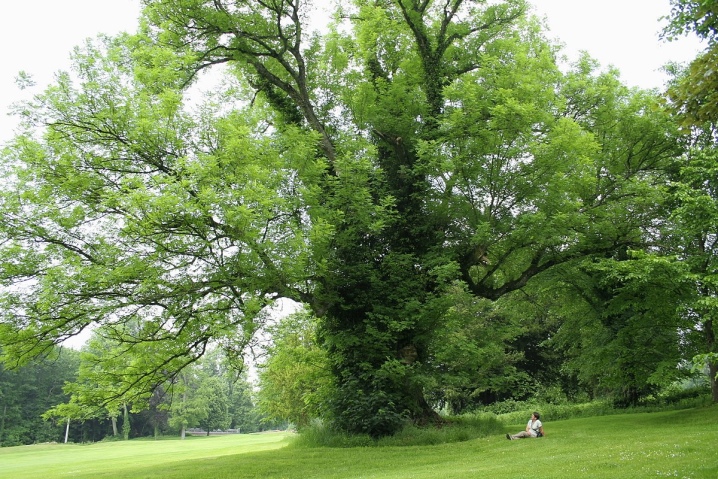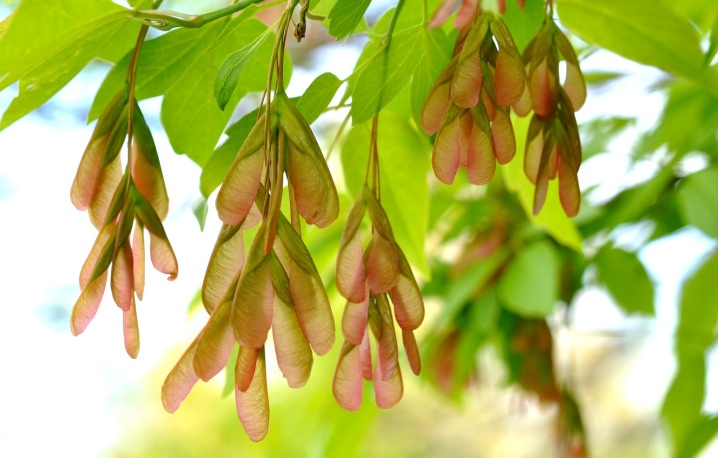Description and use of ash

Ash is not only a majestic tree that adorns forests and parks, but also a supplier of high quality timber. Its many advantages over other crops explain the breadth of its use.

What it is?
The term "ash" means a genus of deciduous trees or multi-stemmed shrubs, belonging to the Olive family and the dicotyledonous class. The plant stretches in height from 5 to 25-35, and sometimes 60 meters, the diameter of its straight trunk reaches a whole meter. The base of the highly raised crown, which looks like an egg, is represented by thick, curved shoots, looking upwards. The smooth grayish bark of a deciduous tree is covered with small cracks in its lower part. Powerful roots are devoid of their pivotal process.
The black buds of the culture are covered with small specks. The shape of small thin leaves, from 4 to 9 centimeters long, resembles a lancet - this type is characterized by the presence of a wedge-shaped base with a solid edge. The leaves are combined in an amount of 3 to 17 pieces on a common cutting, forming a composition up to 40 centimeters long.
Ash foliage is colored in a dark green shade, and the leaf arrangement is opposite. Blooming ash does not smell at all.

Its buds, painted in a lilac or brownish hue, form a bundle-shaped panicle. The flowering of culture is accompanied by the formation of not only male and female, but also bisexual specimens, and all of them can develop on the same tree. Ash fruits are lionfish approximately 4-5 centimeters long. The seeds of the crop, ripening in August, are flat and wide with a taper at the bottom.
Ash seedlings tolerate shade well, but over time the tree becomes more and more light-loving. In the spring, around April-May, the culture blooms. This happens even before the blooming of the leaf blades, so as not to interfere with pollination. Despite the fact that the fruits ripen in the fall, they are harvested for conservation in the summer. By themselves, they fall off only in winter or even at the beginning of next spring. Ash leaves are observed in late autumn, and the blades may still be green. Despite the fact that the plant is frost-hardy, it can suffer from recurrent spring frosts.

Spreading
Ash is a very common crop, found not only in forests, but also in parks and even along transport routes. However, the current habitat is still limited to the Northern Hemisphere. Trees develop most actively on well-moistened and nutritious soils with a neutral acidity level. In Russia, it grows most abundantly in the Volga region, the Tver region, in the Crimea and the Caucasus, as well as in the Amur region. Most of the ash species - about 50, are observed in Asia. Their number in Europe is limited to 10 varieties, and in Central America - 16 varieties.
Common ash and Manchurian ash have the most extensive distribution areas.

Basic properties of wood
The characteristic of ash wood means that it is hard and heavy, processed mainly by mechanical means. The beauty of the natural color of the material explains its rare coloration, but often the boards are treated with wood stain.In order to avoid the appearance of cracks, the raw material must be dried. The texture of the tree is characterized by the presence of an elongated oval pattern. The light color of the material varies depending on the breed: it can be grayish, yellowish, pinkish or even purple.
Despite the rather high hardness of ash and the inability to carry out manual processing, dried raw materials are exposed to mechanical stress without any problems. Hammered nails, self-tapping screws and other fasteners are securely fastened inside. The structure of the material is such that color differences are observed between the kernel and the sapwood: the kernel has a more saturated shade, and the sapwood has a lighter, pinkish or yellowish tone. The visibility of bright fibers in the cut also refers to the characteristics of wood, which takes on a dark brown tint over time.

The elastic material has a small number of heart-shaped rays - no more than 15% of the total volume, as well as high viscosity. The thermal conductivity of treated ash is 20% less than that of untouched wood. A low index, as well as a high density, provide the ability to retain heat, which means that they make ash wood suitable for creating warm floors.
By the way, the density of late wood is three times higher than that of young wood. The material does not absorb external moisture very intensively, but, being in conditions of high humidity, it is still able to slightly increase in volume. This characteristic makes it impossible to use this tree in the interior design of a bath or sauna.
When raw materials are heated to 105 degrees, moisture evaporates, and from 150 degrees, the formation of gaseous products begins. Heat release is possible when reaching 270 degrees. The tree is fully capable of catching fire at temperatures in the range of 450-620 degrees.
Being a hard rock, ash produces a large amount of ash. The high potassium content of the powder makes it an ideal fertilizer for many plants.

Description of popular species
Today, experts identify more than 60 varieties of ash.
American
American ash - the owner of a wide ovoid crown, reaches a height of 20-35 meters. The trunk diameter is about 1 meter. Gray branches with a bluish bloom and whitish lenticels can be slightly pubescent. Red matte buds are covered with specks. The light-loving and unpretentious plant is more frost-resistant than its “relatives”.

Ordinary
The common ash tree, on average, stretches up to 30 meters in height, and its diameter reaches 1.7 meters. The life span of this species can range from 150 to 350 years. The greenish bark darkens and cracks with age. Charcoal-black buds appear on bare shoots. Paniculate inflorescences are formed by May, and the fruits ripen by early autumn. After felling, ordinary ash retains the ability to form pneumatic growth for 70 years. The heat-loving breed partially freezes over in severe winters, and at a young age suffers from spring frosts.
The culture requires fertile soils and reacts extremely negatively to the presence of soda, sodium, calcium and magnesium in the soil, as well as to increased acidity.


White
The height of white ash varies from 8 to 15 meters, and the diameter of the short trunk does not exceed 20-30 centimeters... The rounded crown of this ornamental plant is low-planted. The pubescent buds are colored black. This species loves light, but can develop in shade. Unlike other representatives of the genus, pleasantly smelling snow-white inflorescences appear on it, blooming somewhere in early May. The exquisite reddish tint of the wood makes it attractive for construction. The tree is suitable for both single and group compositions

Nosoliferous
Ash-leaved ash is recognized by its brown bark, covered with light specks and cracks. A beautiful openwork crown makes the variety indispensable in the landscaping process.
The plant grows rather quickly, especially the coarse specimens, and is not afraid of transplants, however, it has low frost resistance.

Fluffy
Fluffy ash is one of the low-growing varieties, and its height never exceeds 20 meters... A spreading crown with felt shoots explains the name of this species. The plant is unpretentious, and therefore is able to develop even along rivers or in flooded areas. It tolerates low temperatures very well.

Green
Green ash is also known as "lanceolate". The unpretentious variety is not afraid of frost or drought, and also develops well, despite the nutritional value of the soil.

Narrow-leaved
Narrow-leaved ash is a decorative representative of the genus, sometimes developing in the form of a bush... Its young shoots have a green, almost black tint.
Outwardly, this plant resembles sharp-fruited ash, differing only in the large size of lionfish and the presence of racemose inflorescences.

Manchurian
Manchurian ash is in many ways similar to ordinary ash... Its straight trunk, reminiscent of a column, grows up to 25 meters in height and about 1.5 meters in diameter. The bark of the tree, which darkens with age, is covered with cracks even in young individuals. A frost-resistant culture nevertheless shows particular demands on the condition of the soil, including the level of its moisture.

Reproduction
In the wild, ash propagates only by seeds - that is, by lionfish, which are carried by the wind.... In principle, the same method can be used for cultivating a plant. Sowing material sprouts quite successfully, but gives shoots only in the second year of life. Much faster results are obtained with crop seedlings. In the nursery, it is possible to purchase specimens from 2 to 10 meters in height, which perfectly take root in the autumn-winter period. Their disembarkation is also not particularly difficult.
Grafting is used to propagate ornamental tree varieties. In this case, a young specimen obtained from a seed or seedling is selected as a rootstock, and the scion is obtained from a tree of the required variety.

Comparison with other trees
Despite the fact that ash is sometimes even difficult to distinguish from oak, the two species are still different in some aspects. For example, oak structures turn out to be slightly stronger and, accordingly, more expensive, and more budgetary ash options do not last so many years. The difference in aesthetic appeal of these two varieties is, of course, relative, except that oak has a more classic color, and ash allows you to experiment with unusual woody patterns.
If we compare ash, beech and larch, then the former will be better in all aspects: stronger, more durable and more attractive. Its hardness is suitable for creating any types of interior products, while soft larch, due to its structure, cannot even be stably leveled, and in addition, it will quickly become covered with scratches and chips.

Applications
Earlier, ash wood was actively used for the manufacture of weapons, hunting tools and even dishes. Today, the material is mostly used to create furniture, stairs, railings, flooring, wooden baseboards and window frames.
On a garden plot, boards subjected to a special impregnation are often used for wall cladding of utility rooms, facing terraces, or even for decorating the main premises of a country house.
Such wood can become the basis for a number of furnishings decorated with carvings - solid kitchens, loft-style doors or cladding furniture panels.

Considering that such raw materials bend well and are not chipped, high-quality sports equipment is produced from it: paddles, golf clubs, skis, parallel bars, tennis rackets and other equipment. Ash plywood is ideal for decorating musical instruments, car interiors and even cars.
It is worth mentioning that two types of raw materials are most often used in production: heat treated and cut. The first is exposed to high temperatures, which absolutely prevents the appearance of fungi and the reproduction of pests. Processing changes the molecular composition of wood, creating additional protection for it against deformations that occur when the moisture level changes. The structure of such ash becomes more attractive, and the service life is improved, but, accordingly, the cost of production also increases. Edged ash is mainly chosen for construction - floor or wall decoration.

































































The comment was sent successfully.